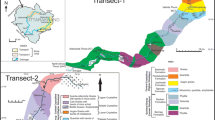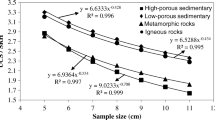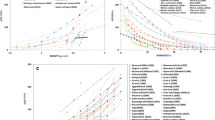Abstract
Volcanic rocks from the Bodrum Peninsula have been studied to establish a relationship between the uniaxial compressive strength (UCS), Young’s modulus (E) and Schmidt hammer rebound number (N). Test results obtained on andesites, basalts and tuffs have been assessed statistically and the parameters obtained correlated. Regression equations were established between N, E and UCS.
The study suggests the following empirical relationships: UCS=2.75 N−36.83, E=0.17 UCS+0.28 and E=0.47 N−6.25. The relationships are somewhat different from the correlations suggested by previous studies and should therefore be used only for andesites, basalts and tuffs with degrees of weathering and mineralogical structure similar to those used in the present study. The results obtained using solely the Schmidt hammer test for estimating mechanical properties of rocks are less accurate than when a full suite of laboratory tests is carried out but it is hoped that these empirical equations will help geotechnical engineers making practical decisions at a preliminary site investigation stage.
Résumé
Les roches volcaniques de la péninsule de Bodrum ont été étudiées afin d’établir une relation entre la résistance à la compression simple (UCS), le module d’Young (E) et l’indice de rebond au marteau de Schmidt (N). Les résultats obtenus sur des andésites, des basaltes et des tufs ont fait l’objet de traitements statistiques. Des corrélations ont été établies entre les paramètres N, E et UCS.
L’étude conduit à retenir les relations empiriques suivantes: UCS=2,75 N−36,38; E=0,17 UCS+0,28 et E=0,47 N−6,25. Les relations obtenues sont quelque peu différentes de celles résultant d’études antérieures et, de ce fait, ne doivent être utilisées que pour des andésites, des basaltes et des tufs, présentant par ailleurs des compositions minéralogiques et des degrés d’altération similaires à ceux des roches considérées dans cette étude. Les résultats obtenus à partir du seul essai au marteau de Schmidt, pour estimer les propriétés mécaniques des roches, sont moins précis que si des essais mécaniques de laboratoire sont réalisés mais on espère que ces relations empiriques aideront les ingénieurs géotechniciens pour des décisions pratiques au stade des reconnaissances préliminaires de site.







Similar content being viewed by others
References
Aggıstalıs G, Alıvızatos A, Stamoulıs D, Stournaras G (1996) Correlating uniaxial compressive strength with Schmidt hammer rebound number, point load index, Young’s modulus, and mineralogy of gabbros and basalts (Northern Greece). Bull Eng Geol 54:3–11
Aufmuth ER (1973) A systematic determination of engineering criteria for rocks. Bull Assoc Eng Geol 11:235–245
Barton N, Choubey V (1977) The shear strength of rock joints in theory and practice. Rock Mech 10:1–54
Beverly BE, Schoenwolf DA, Brierly GS (1979) Correlations of rocks index values with engineering properties and the classification of intact rocks.
Deere DU, Miller RP (1966) Engineering classification and index properties for intact rocks. Tech Rep Air Force Weapons Lab, New Mexico, no AFNL-TR, pp 65–116
Ercan T, Türkecan A, ve Günay E (1982) Bodrum Yarımadasının Jeolojisi Maden Tetkik Arama Enst Derg 97/98:21–32
Ercan T, Erdoğdu G, Türkecan A (1984) Bodrum Yarımadasındaki Mağmatik Kayaçların Petrolojisi ve Kökensel Yorumu. Türkiye Jeoloji Kurumu Bülteni 27:85–89
Ghose AK, Chakraborti S (1986) Empirical strength indices of Indian coals—an investigation. Proceedings of 27th US symposium on rock mechanics, Balkema, Rotherdam, pp 59–61
Gökçeoğlu C (1996) Schmidt sertlik çekici kullanılarak tahmin edilen tek eksenli basınç dayanımı verilerinin güvenirliği üzerine bir değerlendirme. Jeol Müh 48:78–81
Haramy KY, DeMarco MJ (1985) Use of Schmidt hammer for rock and coal testing. Proceedings of 26th US symposium on rock mechanics, 26–28 June, Rapid City, pp 549–555
ISRM (1981a) Suggested methods for determining the uniaxial compressive strength and deformability of rock materials. International society for rock mech. Commission on standardisation of laboratory and field tests, pp 111–116
ISRM (1981b) Suggested methods for determining hardness and abrasiveness of rocks, part 3. Commission on standardisation of laboratory and field tests, pp 101–102
Kahraman S (1996) Basınç direnci tahmininde schmidt ve nokta yük indeksi kullanmanın güvenirliği. In: Korkmaz ve S, Akçay M (eds) KTÜ Jeoloji Mühendisliği Bölümü 30. Yıl Sempozyumu Bildiriler Kitabı, Trabzon, pp 362–369
Kindybinski A (1980) Bursting liability indices of coal. Int J Rock Mech Min Sci Geomech Abstr 17:167–161
Katz O, Reches Z, Roegiers JC (2000) Evaluation of mechanical rock properties using a Schmidt hammer. Tech Note Int J Rock Mech Min Sci 37:723–728
Miller RP (1965) Engineering classification and index properties for intact rock. PhD thesis, University of Illinois
O’Rourke JE (1989) Rock index properties for geo-engineering in underground development. Min Eng 106–110
Sachpazis CI (1990) Correlating Schmidt hammer rebound number with compressive strength and Young’s modulus of carbonate rocks. Bull Int Assoc Eng Geol 42:75–83
Schmidt E (1951) A non-destructive concrete tester. Concrete 59(8):34–35
Shorey PR, Barat D, Das MN, Mukherjee KP, Singh B (1984) Schmidt hammer rebound data for estimation of large scale in-situ coal strength. Tech Note Int J Rock Mech Min Sci Geomech Abstr 21:39–42
Singh RN, Hassani FP, Elkington PAS (1983) The application of strength and deformation index testing to the stability assessment of coal measures excavations. Proceedings of 24th US symposium on rock mechanics, Texas A&M Univ, AEG, pp 599–609
Xu S, Grasso P, Mahtab A (1990) Use of Schmidt hammer for estimating mechanical properties of weak rock. 6th Int IAEG Congress Balkema, Rotterdam, pp 511–519
Yılmaz I, Sendir H (2002) Correlation of Schmidt hammer rebound number with unconfined compressive strength and Young’s modulus in gypsum from Sivas (Turkey). Eng Geol 66:211–219
Author information
Authors and Affiliations
Corresponding author
Rights and permissions
About this article
Cite this article
Dinçer, I., Acar, A., Çobanoğlu, I. et al. Correlation between Schmidt hardness, uniaxial compressive strength and Young’s modulus for andesites, basalts and tuffs. Bull Eng Geol Environ 63, 141–148 (2004). https://doi.org/10.1007/s10064-004-0230-0
Received:
Accepted:
Published:
Issue Date:
DOI: https://doi.org/10.1007/s10064-004-0230-0




